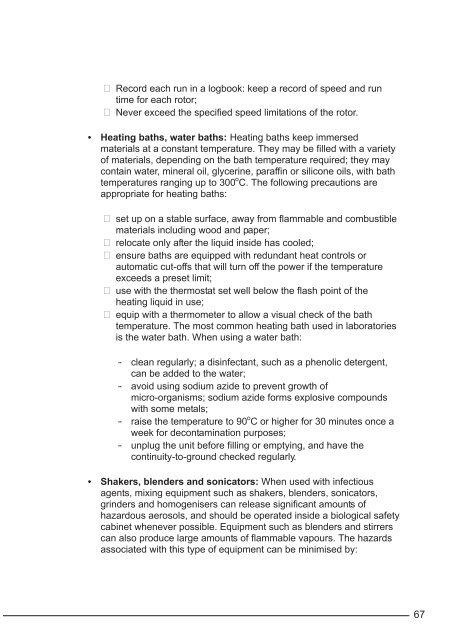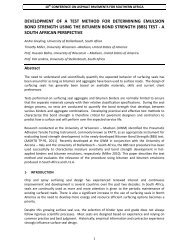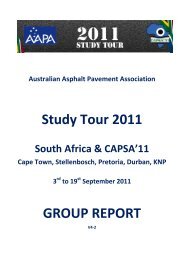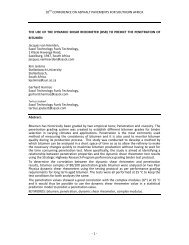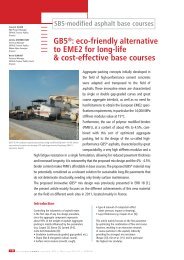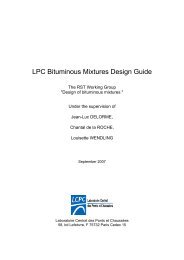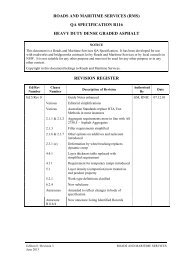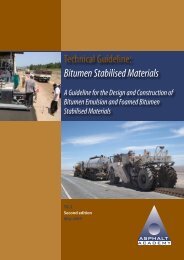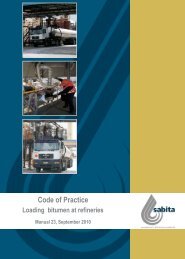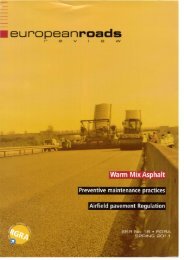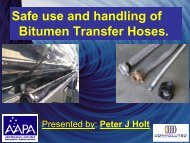Guide to the safe handling of solvents in a bituminous ... - Aapaq.org
Guide to the safe handling of solvents in a bituminous ... - Aapaq.org
Guide to the safe handling of solvents in a bituminous ... - Aapaq.org
- No tags were found...
Create successful ePaper yourself
Turn your PDF publications into a flip-book with our unique Google optimized e-Paper software.
Record each run <strong>in</strong> a logbook: keep a record <strong>of</strong> speed and runtime for each ro<strong>to</strong>r; Never exceed <strong>the</strong> specified speed limitations <strong>of</strong> <strong>the</strong> ro<strong>to</strong>r.• Heat<strong>in</strong>g baths, water baths: Heat<strong>in</strong>g baths keep immersedmaterials at a constant temperature. They may be filled with a variety<strong>of</strong> materials, depend<strong>in</strong>g on <strong>the</strong> bath temperature required; <strong>the</strong>y mayconta<strong>in</strong> water, m<strong>in</strong>eral oil, glycer<strong>in</strong>e, paraff<strong>in</strong> or silicone oils, with bathtemperatures rang<strong>in</strong>g up <strong>to</strong> 300 o C. The follow<strong>in</strong>g precautions areappropriate for heat<strong>in</strong>g baths: set up on a stable surface, away from flammable and combustiblematerials <strong>in</strong>clud<strong>in</strong>g wood and paper; relocate only after <strong>the</strong> liquid <strong>in</strong>side has cooled; ensure baths are equipped with redundant heat controls orau<strong>to</strong>matic cut-<strong>of</strong>fs that will turn <strong>of</strong>f <strong>the</strong> power if <strong>the</strong> temperatureexceeds a preset limit; use with <strong>the</strong> <strong>the</strong>rmostat set well below <strong>the</strong> flash po<strong>in</strong>t <strong>of</strong> <strong>the</strong>heat<strong>in</strong>g liquid <strong>in</strong> use; equip with a <strong>the</strong>rmometer <strong>to</strong> allow a visual check <strong>of</strong> <strong>the</strong> bathtemperature. The most common heat<strong>in</strong>g bath used <strong>in</strong> labora<strong>to</strong>riesis <strong>the</strong> water bath. When us<strong>in</strong>g a water bath:¨¨¨¨clean regularly; a dis<strong>in</strong>fectant, such as a phenolic detergent,can be added <strong>to</strong> <strong>the</strong> water;avoid us<strong>in</strong>g sodium azide <strong>to</strong> prevent growth <strong>of</strong>micro-<strong>org</strong>anisms; sodium azide forms explosive compoundswith some metals;raise <strong>the</strong> temperature <strong>to</strong> 90 o C or higher for 30 m<strong>in</strong>utes once aweek for decontam<strong>in</strong>ation purposes;unplug <strong>the</strong> unit before fill<strong>in</strong>g or empty<strong>in</strong>g, and have <strong>the</strong>cont<strong>in</strong>uity-<strong>to</strong>-ground checked regularly.• Shakers, blenders and sonica<strong>to</strong>rs: When used with <strong>in</strong>fectiousagents, mix<strong>in</strong>g equipment such as shakers, blenders, sonica<strong>to</strong>rs,gr<strong>in</strong>ders and homogenisers can release significant amounts <strong>of</strong>hazardous aerosols, and should be operated <strong>in</strong>side a biological <strong>safe</strong>tycab<strong>in</strong>et whenever possible. Equipment such as blenders and stirrerscan also produce large amounts <strong>of</strong> flammable vapours. The hazardsassociated with this type <strong>of</strong> equipment can be m<strong>in</strong>imised by:67


